When it comes to household appliances, few are as essential and widely used as the washing machine – a true lifesaver for busy individuals and families alike. However, this beloved device is not without its faults, and one of the most common issues that homeowners face is leakage. But what are the factors that contribute to this frustrating problem?
Leakage in washing machines can stem from a variety of sources, each requiring a different approach to resolve. The deluge of water may be triggered by a malfunctioning component, an improper installation, or the wear and tear of certain parts over time. Understanding the underlying causes is imperative in order to effectively address the issue and prevent further damage to both the machine and the surrounding area.
In this article, we embark on a quest to demystify the leakage phenomenon, exploring the potential culprits and shedding light on the solutions that can rectify the problem. By highlighting the significance of regular maintenance and proper usage, we aim to empower homeowners to take control of their washing machines, ensuring efficient and trouble-free laundry days.
Common Reasons for Water Leakage in Washing Machines
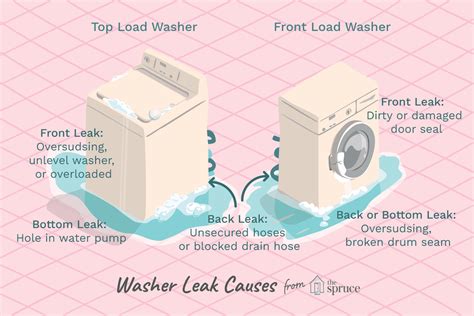
A washing machine is a complex appliance that can experience water leakage due to various factors. Understanding the causes of washing machine leaks is essential to prevent further damage and ensure the efficiency of the machine. Leakage can occur as a result of multiple reasons, including malfunctioning components, worn-out seals, or loose connections.
| Possible Causes of Washing Machine Leaks | Description |
|---|---|
| 1. Faulty Inlet Valve | The inlet valve controls the flow of water into the washing machine. If it is defective or damaged, it can lead to leaks. |
| 2. Damaged Door Seal | The door seal, also known as the gasket, creates a watertight seal when the door is closed. Over time, it can wear out or become damaged, resulting in water leakage. |
| 3. Loose Connections | If the hose connections are loose, water can escape from the washing machine during the wash or spin cycles. |
| 4. Clogged Drain Pump | A clogged or malfunctioning drain pump can lead to water accumulation and leakage in the washing machine. |
| 5. Excessive Detergent Usage | Using too much detergent can cause excessive suds, leading to overflow and leakage from the washing machine. |
Identifying the specific cause of the leakage is crucial in implementing the appropriate solution. By addressing these common causes, you can prevent water leakage in your washing machine and ensure its optimal performance.
Faulty Door Seal or Gasket
One possible factor that can contribute to the problem of water leakage in a washing machine is a faulty door seal or gasket. Inadequate sealing of the washing machine door can result in water seeping out during the washing cycle, leading to potential damage and inconvenience. It is essential to ensure that the door seal or gasket is in proper working condition to prevent any leaks from occurring.
| Cause | Solution |
|---|---|
| The door seal or gasket is worn out or damaged. | Inspect the seal or gasket for signs of wear and tear. Replace it if necessary to ensure a proper seal. |
| The seal or gasket is not correctly aligned. | Adjust the position of the seal or gasket to ensure it is properly aligned with the door. Reinstall or tighten any loose components if necessary. |
| Debris or foreign objects are obstructing the sealing mechanism. | Clean the seal or gasket thoroughly, removing any accumulated dirt, debris, or foreign objects that may affect its functionality. |
| The door is not closing properly. | Check if there are any obstructions preventing the door from closing fully. Ensure that the latch or locking mechanism is functioning correctly. |
| Excessive detergent or fabric softener usage causing excess foam. | Use the appropriate amount of detergent and fabric softener recommended by the manufacturer. Excessive foam can put pressure on the door seal, leading to leaks. |
By addressing any issues with the door seal or gasket, you can significantly reduce the risk of water leakage in your washing machine. Regular maintenance, inspection, and prompt replacement of worn-out components will help ensure efficient and leak-free washing cycles.
Loose or Damaged Water Inlet Hose
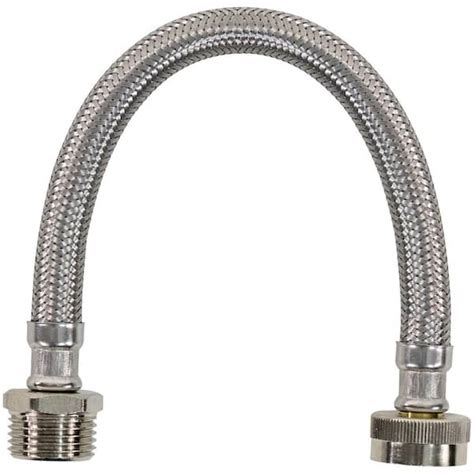
In this section, we will be discussing a potential cause of water leakage in your washing machine - a loose or damaged water inlet hose. The water inlet hose is responsible for supplying water from your home's water supply to the washing machine. If this hose is loose or damaged, it can lead to water leakage during the wash cycle.
Clogged or Damaged Drain Pump
One commonly encountered issue that may result in a leaking washing machine is a clogged or damaged drain pump. The drain pump plays a crucial role in removing water from the machine during the washing and spinning cycles. If the pump becomes clogged or damaged, it can lead to water leakage.
Clogged Drain Pump: A clogged drain pump can occur due to the accumulation of debris such as coins, lint, hair, or small objects in the pump filter or impeller. When these blockages prevent proper water drainage, the excess water may leak from the machine. Regularly checking and cleaning the pump filter can help prevent clogs and subsequent leakage.
Synonyms: Obstructed Drain Pump, Blocked Drain Pump
Damaged Drain Pump: A damaged drain pump can result from wear and tear, mechanical issues, or power surges. When the pump is damaged, it may not be able to effectively remove water from the machine, causing leaks. In such cases, repairing or replacing the drain pump is necessary to resolve the leakage problem.
Synonyms: Malfunctioning Drain Pump, Faulty Drain Pump
Identifying and resolving issues with the drain pump is essential in addressing washing machine leaks. Regular maintenance, including cleaning and checking the pump, can help prevent clogs and damage that may result in water leakage.
Problems with Excessive Detergent or Fabric Softener Usage
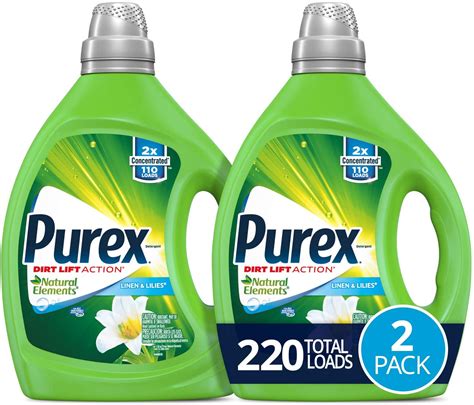
When it comes to ensuring the cleanliness and freshness of our laundry, using detergent and fabric softeners are essential steps. However, the excessive use of these products can lead to a significant issue in washing machines – overflowing.
Overflowing detergent or fabric softener occurs when too much of these cleaning agents are added to the washing machine during a wash cycle. As a result, an excessive amount of suds is created, causing the washing machine to overflow with water and detergent mixture.
This issue poses several concerns. Firstly, an overflowing washing machine can lead to water leakage, causing potential damage to the surrounding area. Additionally, excessive suds can hinder the effective functioning of the washing machine, affecting its ability to clean clothes thoroughly.
To prevent the problem of overflowing detergent or fabric softener, it is vital to follow the manufacturer's instructions regarding the appropriate dosage of these cleaning agents. Using the recommended amount will ensure that the washing machine operates efficiently without any leakage or excessive suds formation.
Moreover, being mindful of the size of the load being washed and adjusting the detergent or fabric softener accordingly can also prevent overflow issues. Overloading the washing machine can result in insufficient water circulation and increased sudsing, leading to an overflow.
In summary, the issue of overflowing detergent or fabric softener can be a result of using excessive amounts of these cleaning agents or not considering the appropriate load size. By following the guidelines provided, we can avoid the potential damages caused by an overflowing washing machine and maintain its optimal performance.
Excessive or Unbalanced Load
In cases where a washing machine experiences leakage issues, one potential cause could be an excessive or unbalanced load. This occurs when the amount of laundry inside the machine is either too large or distributed unevenly. Such imbalances can put a strain on the machine's internal components and result in leaks. Uncontrolled water flow and unbalanced spinning are common symptoms of this particular problem.
When the laundry load exceeds the recommended capacity, it puts undue stress on the washing machine's motor and drum. The increased weight can cause the machine to vibrate excessively during the spin cycle, leading to leaks from various points. Additionally, if the articles of clothing are not evenly distributed within the drum, an imbalance occurs. This creates an uneven load distribution, exacerbating the problem further.
To avoid excessive or unbalanced loads, it is essential to follow the manufacturer's guidelines regarding laundry capacity. Overstuffing the machine or washing bulky items all at once can strain the components, potentially causing leaks. Distributing the laundry evenly and loosely within the drum can help prevent imbalances and minimize vibrations during the spin cycle. Moreover, using additional safety measures like adjusting the machine's leveling legs can help ensure stability and reduce the likelihood of leakage.
If a washing machine is consistently experiencing leaks due to excessive or unbalanced loads, it is advisable to address the issue promptly. Taking proactive measures, such as dividing large loads into smaller ones or rearranging the laundry before starting the cycle, can help mitigate the problem. By adhering to proper loading techniques and maintaining a balanced load, the risk of leakage due to excessive or unbalanced loads can be significantly reduced, thereby extending the life of the washing machine.
Possible Solutions for Water Leakage in your Washing Appliance
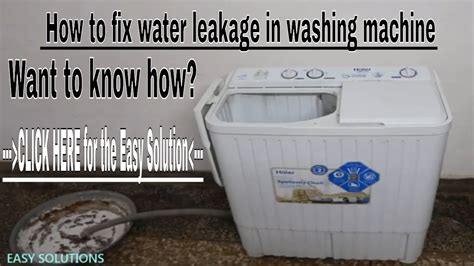
Leakage in a washing machine can cause inconvenience and potential damage to your home. Fortunately, there are several effective ways to address this issue and prevent further leaks. By following these solutions, you can save both time and money by avoiding costly repairs or replacement of your washing machine.
1. Check the hose connections: Inspect the hoses connecting your washing machine to the water supply lines and the drain. Make sure that they are properly secured and tightened. If there are any loose connections, tighten them using a wrench. Consider replacing old or damaged hoses with new ones to ensure a secure connection and prevent leaks.
2. Examine the door seal: The door seal, also known as the gasket, prevents water from leaking out during the washing cycle. Over time, the seal may become worn out or damaged, causing leaks. Carefully inspect the door seal for any signs of cracks, tears, or gaps. If you notice any issues, replace the door seal with a new one to effectively eliminate the leakage problem.
3. Clean the detergent dispenser: A clogged or dirty detergent dispenser can cause water to overflow and leak from your washing machine. Regularly clean the detergent dispenser to remove any residue or debris that may be blocking the flow of water. Follow the manufacturer's instructions on how to properly clean and maintain the dispenser to prevent leakage.
4. Inspect the water inlet valve: The water inlet valve controls the flow of water into the washing machine. A faulty valve can lead to water leakage. Check for any signs of damage or corrosion on the valve. If necessary, replace the water inlet valve to ensure proper water flow and eliminate leaks.
5. Avoid overloading the machine: Overloading the washing machine with excessive clothes can put extra pressure on the internal components, leading to leaks. Follow the manufacturer's guidelines on the maximum load capacity and avoid exceeding it. By properly balancing the load and avoiding overloading, you can prevent leaks and prolong the life of your washing machine.
By implementing these possible solutions, you can address and resolve water leakage issues in your washing machine. Remember to regularly inspect and maintain your appliance to prevent future leaks and ensure its optimal performance.
Inspect and Replace Faulty Door Seal or Gasket
In this section, we will explore an important aspect of troubleshooting a leaking washing machine - inspecting and replacing the malfunctioning door seal or gasket. The door seal or gasket is a crucial component that prevents water from leaking out of the machine during the wash and spin cycles. Over time, wear and tear, along with various factors, can cause the seal or gasket to become faulty, resulting in water leakage.
To begin the inspection process, start by visually examining the door seal or gasket for any signs of damage or deterioration. Look for cracks, tears, or any visible gaps in the seal. Additionally, check if the seal is properly aligned and tightly fitted to the door. Any misalignment or loose fitting could lead to leakage.
If you notice any issues with the door seal or gasket, it is recommended to replace it promptly. Start by referring to the washing machine's manual or manufacturer's instructions for the correct replacement part. Next, gather the necessary tools such as a screwdriver or pliers to aid in the removal of the old seal or gasket.
When proceeding with the replacement, take note of the specific steps mentioned in the manual or instructions. Begin by carefully removing the old seal or gasket from its position. Be cautious not to damage any other components of the machine during this process. Once the old seal or gasket is removed, thoroughly clean the area to ensure there is no debris or residue left behind.
Now, it is time to install the new seal or gasket. Follow the instructions provided, making sure to align it properly and firmly secure it in place. Double-check that the seal or gasket is tightly fitted, leaving no room for water to escape. Once the replacement is complete, perform a test run of the washing machine to ensure there are no further leaks.
Inspecting and replacing a faulty door seal or gasket can play a significant role in resolving the issue of a leaking washing machine. By taking the necessary steps to address this problem, you can potentially avoid further damage to the machine and prevent water-related accidents in your home.
Tighten or Replace Loose or Damaged Water Inlet Hose

In this section, we will discuss the importance of ensuring the proper connection and condition of the water inlet hose in your washing machine. It is crucial to address any issues with the hose, such as looseness or damage, as they can lead to water leakage during the wash cycle.
One of the primary causes of a leaking washing machine is a loose or damaged water inlet hose. The water inlet hose is responsible for supplying water to the washing machine during the wash cycle. Over time, the connection between the hose and the water supply valve or the machine itself may become loose, causing water to escape. Additionally, the hose may develop cracks or splits due to wear and tear, leading to water leakage.
To prevent water leakage, it is essential to regularly check the water inlet hose for any signs of damage or looseness. If you notice any cracks, splits, or loose connections, it is recommended to tighten or replace the hose promptly. By doing so, you will ensure a secure and reliable water supply to your washing machine, eliminating the risk of leaks.
| Steps to Tighten or Replace a Water Inlet Hose |
|---|
| 1. Turn off the water supply valve |
| 2. Disconnect the water inlet hose from the valve or machine |
| 3. Inspect the hose for any signs of damage or wear |
| 4. If the hose is damaged, purchase a replacement hose of the same length and diameter |
| 5. If the hose is in good condition but loose, use pliers to tighten the connection |
| 6. Reconnect the hose to the valve or machine |
| 7. Turn on the water supply valve and check for any leaks |
By following these steps, you can effectively tighten or replace a loose or damaged water inlet hose, thereby preventing water leakage and ensuring the smooth operation of your washing machine.
Clean or Replace Clogged or Damaged Drain Pump
Proper maintenance of your washing machine involves ensuring that all components are in good working condition. One vital component that contributes to the smooth operation of the machine is the drain pump. Over time, the drain pump may become clogged or damaged, leading to leaks and other issues.
If you notice water leaking from your washing machine, it is crucial to inspect and clean or replace the drain pump as necessary. A clogged or damaged drain pump can cause water to overflow, resulting in a mess and potential damage to your appliance and surrounding areas.
To determine if the drain pump is the culprit behind the leaks, start by disconnecting the power supply and water source to your washing machine. Then, locate the drain pump, which is usually situated at the back or bottom of the machine. Check for any visible blockages or signs of damage, such as cracks or leaks.
| Steps to Clean the Drain Pump: | Steps to Replace the Drain Pump: |
|---|---|
|
|
Regularly inspecting and maintaining the drain pump can prevent leaks and the associated problems. It is advisable to refer to the user manual or seek professional assistance if you are unsure about the cleaning or replacement process. By keeping the drain pump clean and functional, you can ensure the efficient and leak-free performance of your washing machine.
Using the Right Amount of Detergent and Fabric Softener
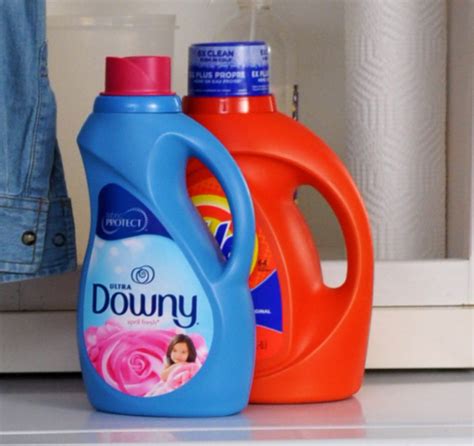
When it comes to using your washing machine, selecting the appropriate amount of detergent and fabric softener is crucial. This section aims to shed light on the significance of proper measurements to prevent leaks and maintain the efficiency of your machine. By ensuring the correct dosage, you can preserve the quality of your laundry while avoiding any potential issues that may arise from excessive or insufficient amounts of detergent and fabric softener.
Detergent: Utilizing the correct quantity of detergent is essential and can have a significant impact on the performance and longevity of your washing machine. Too much detergent may result in excessive suds, which may overflow and cause leaks during the wash cycle. On the other hand, using too little detergent may not effectively clean your laundry, leading to the need for additional wash cycles and ultimately wasting water and energy.
Fabric Softener: Fabric softener can enhance the feel and smell of your clothes, but it should also be used with caution. Overusing fabric softener can create a residue buildup within the machine, potentially clogging the drainage system and causing leaks. It is important to follow the recommended dosage guidelines provided by the manufacturer to prevent any issues and maintain the proper functioning of your washing machine.
In conclusion, using the appropriate amount of detergent and fabric softener is crucial for a well-operating and leak-free washing machine. By adhering to recommended measurements, you can ensure that your laundry is clean and fresh without risking any potential damage or unwelcome leakage. Remember to consult the manufacturer's instructions and recommendations for optimal usage to keep your machine running smoothly and efficiently.
Ensure Proper Loading and Balancing of Clothes in the Machine
One crucial factor that contributes to a washing machine leaking is the improper loading and balancing of clothes inside the appliance. The way you load your clothes affects the performance and efficiency of the washing machine during the wash cycle. Therefore, it is essential to pay attention to the proper loading and balancing techniques to prevent leaks and other issues.
When loading the washing machine, it is important to distribute the clothes evenly to maintain balance. Uneven distribution can cause the machine to vibrate excessively during the spin cycle, leading to leaks and potential damage to the appliance. To ensure proper balancing, try to distribute the lightweight and heavyweight items evenly throughout the machine.
Additionally, avoid overloading the washing machine beyond its capacity. Overloading can strain the machine's components and compromise its ability to operate effectively. It can also lead to an imbalance in the load, increasing the likelihood of leaks. Be mindful of the manufacturer's guidelines regarding the maximum load capacity, and follow those recommendations accordingly.
Furthermore, consider the type of garments you are washing. Bulky items, such as blankets or large towels, require more space and can disrupt the balance if not loaded properly. It is advisable to wash these items separately or in smaller loads to avoid overloading the machine and prevent leaks.
In conclusion, ensuring the proper loading and balancing of clothes in the washing machine is essential to prevent leaks. By evenly distributing the clothes and avoiding overloading, you can maintain the balance of the machine and promote its efficient functioning. Taking these precautions will not only prevent leaks but also help prolong the lifespan of your washing machine.
FAQ
Why is my washing machine leaking?
There can be several reasons why your washing machine is leaking. It could be due to a damaged hose, a loose connection, a faulty pump, or even an overflowing water level.
How can I identify the source of the leak in my washing machine?
To identify the source of the leak in your washing machine, you can perform a few simple checks. First, inspect the hoses for any cracks or damage. Next, ensure that all connections are tight and secure. Additionally, check if the water level inside the machine is reaching the correct level. Lastly, examine the pump for any signs of malfunction.
What should I do if I notice my washing machine leaking?
If you notice your washing machine leaking, the first thing you should do is turn off the power supply and the water source to the machine. This will help prevent any further damage and avoid potential hazards. Once you have done that, you can proceed to identify the source of the leak and take appropriate action, such as tightening connections, replacing damaged hoses, or calling a professional for assistance.
Can I fix a leaking washing machine myself?
In some cases, you may be able to fix a leaking washing machine yourself. If the problem is a loose connection or a damaged hose, you can try tightening the connection or replacing the hose with a new one. However, if the issue is more complex, such as a faulty pump or a problem with the internal mechanisms, it is recommended to seek professional help to avoid causing further damage or voiding any warranties.
What are some preventive measures to avoid a washing machine leak?
To prevent a washing machine leak, there are a few preventive measures you can take. Regularly inspect the hoses for any signs of wear or damage and replace them if necessary. Ensure all connections are tight and secure, and avoid overloading the machine with excessive laundry. Additionally, clean the detergent dispenser and the drum regularly to prevent clogs or blockages. Performing these maintenance tasks can help maintain the proper functioning of your washing machine and minimize the risk of leaks.




